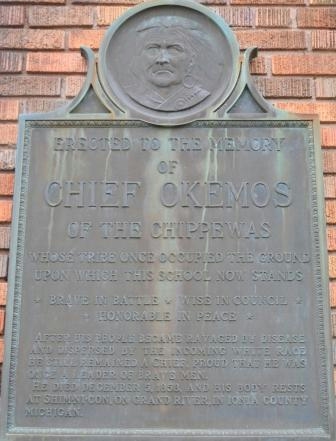 |
| LOCATION: |
Okemos, Michigan - Central Elementary
School - 4406 Okemos Road |
| AS IT READS: |
ERECTED TO THE MEMORY
OF CHIEF OKEMOS OF THE CHIPPEWAS WHOSE TRIBE ONCE OCCUPIED THE
GROUND UPON WHICH THIS SCHOOL NOW STANDS.
* BRAVE IN BATTLE *
WISE IN COUNCIL * HONORABLE IN PEACE *
AFTER HIS PEOPLE
BECAME RAVAGED BY DISEASE AND DISPERSED BY THE INCOMING WHITE RACE
HE STILL REMAINED A CHIEF PROUD THAT HE WAS ONCE A LEADER OF BRAVE
MEN. HE DIED DECEMBER 5TH, 1858 AND HIS BODY RESTS AT SHIM-NI-CON
ON GRAND RIVER IN IONIA COUNTY MICHIGAN. |
| NOTES: |
This bronze plaque was dedicated on
October 19, 1923 when the school was built. This building now
houses Central Montessori Elementary and Okemos Public Schools
Administration Offices. Originally known as "Okemos
Consolidated Agricultural School" housing all grades, it then became solely
Okemos High School later. The "Chief Okemos Memorial Tablet"
is listed with the Smithsonian Institute. It's sculptor is unknown |
|
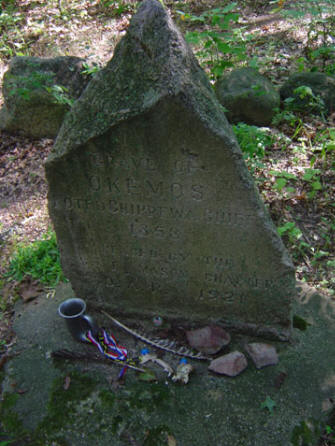 |
| LOCATION: |
Dansby Township/Portland, Michigan |
| AS IT READS: |
Grave of - Okemos - Noted Chippewa Chief - 1858
Place by the - S. T. Mason Chapter - D.A.R. 1921 |
| NOTES: |
The D.A.R. is an acronym for the
Daughters of the American Revolution (DAR) is a service
organization for women who are descended from a person involved in
United States' independence. The DAR places an emphasis on the
preservation and respect concerning historical heritage.
credit |
|
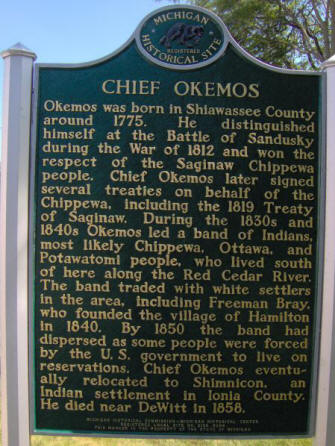
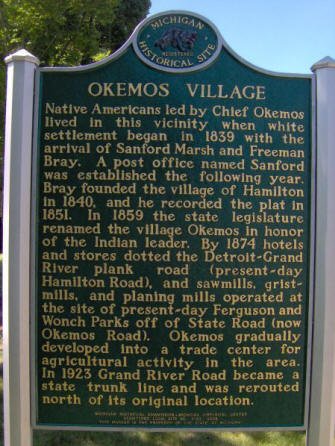 |
| LOCATION: |
Okemos, Michigan - Southwest Corner
of Okemos Road and Hamilton Road |
| AS IT READS: |
CHIEF OKEMOS (facing south)
Okemos was born in Shiawassee County around 1775. He distinguished
himself at the Battle of Sandusky during the War of 1812 and won
the respect of the Saginaw Chippewa people. Chief Okemos later
signed several treaties on behalf of the Chippewa, including the
1819 Treaty of Saginaw. During the 1830s and 1840s Okemos led a
band of Indians, most likely Chippewa, Ottawa, and Potawatomi
people, who lived south of here along the Red Cedar River. The
band traded with white settlers in the area, including Freeman
Bray, who founded the village of Hamilton in 1840. By 1850 the
band had dispersed as some people were forced by the U.S
government to live on reservations, Chief Okemos eventually
relocated to Shimnicon, an Indian settlement in Ionia County. He
died near DeWitt in 1858.
OKEMOS VILLAGE (facing north)
Native Americans led by Chief Okemos lived in this vicinity when
white settlement began in 1839 with the arrival of Sanford Marsh
and Freeman Bray. A post office named Sanford was established the
following year. Bray founded the village of Hamilton in 1940, and
he recorded the plat in 1851. In 1859 the state legislature
renamed the village Okemos in honor of the Indian leader. By 1874
hotels and stores dotted the Detroit-Grand River plank road
(present-day Hamilton Road), and sawmills, gristmills, and
planning mills operated at the site of present-day Ferguson and
Wonch Parks off of State Road (now Okemos Road). Okemos gradually
developed into a trade center for agricultural activity in the
area. In 1923 Grand River Road became a state trunk line and was
rerouted north of its original location.
|
| NOTES: |
|
|
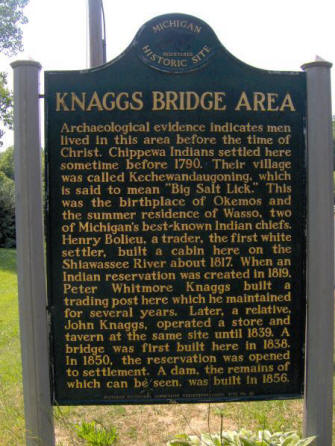 |
| LOCATION: |
Bancroft, Michigan - South side of East Cole Road,
on the Shiawassee River |
| AS IT READS: |
Archaeological evidence indicates men lived in this area before
the time of Christ. Chippewa Indians settled here sometime before
1790. Their village was called Kechewandaugoning, which is said to
mean "Big Salt Lick." This was the birthplace of Okemos and the
summer residence of Wasso, two of Michigan's best known Indian
chiefs. Henry Bolieu, a trader, the first white settler, built a
cabin here about 1817. When an Indian reservation was created in
1819, Peter Whitmore Knagg built a trading post here which he
maintained for several years. Later, a relative, John Knaggs,
operated a store and tavern at the same site until 1839. A bridge
was first built here in 1838. In 1850, the reservation was opened
to settlement. A dam, the remains of which can be seen, was built
in 1856. |
| NOTES: |
credit |
|
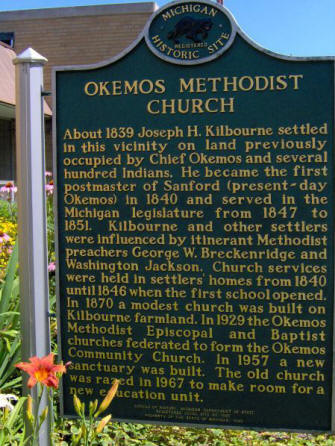 |
| LOCATION: |
Okemos, Michigan |
| AS IT READS: |
About 1839 Joseph H. Kilbourne settled in this vicinity on land
previously occupied by Chief Okemos and several hundred Indians.
He became the postmaster of Sanford (present-day Okemos) in 1840
and served in the Michigan legislature from 1847 to 1851.
Kilbourne and other settlers were influenced by itinerant
Methodist preachers George W. Breckenridge and Washington Jackson.
Church services were held in settler's homes from 1840 until 1846
when the first school opened. In 1870 a modest church was built on
Kilbourne farmland. In 1929 the Okemos Methodist Episcopal and
Baptist churches federated to form the Okemos Community Church. In
1957 a new sanctuary was built. The old church was razed in 1967
to make room for a new education unit. |
| NOTES: |
While the village was named Hamilton,
the post office was established as Sandford in 1840. The name of
the village and post office were synced when the community
official became named Okemos in 1859. |
|
 |
| LOCATION: |
Mason, Michigan - 'Old' Ingham County
Court House |
| AS IT READS: |
mural of an early
Indian scene with Chief John Okemos,
a familiar character
trading with settlers of this vicinity along the Red Cedar in the
Okemos area. |
| NOTES: |
On the east wall
in main foyer. |
|
 |
| LOCATION: |
Mason, Michigan |
| AS IT READS: |
This handsome brick structure, said to be the oldest remaining
house in Mason, is one of the most elaborate and best preserved
Greek Revival houses in Ingham County. Pioneer John Rayner, a
native of New York State, began construction of this farmhouse in
1840. The original Rayner farm totaled 320 acres. The ponds in the
park opposite this site were dug to supply ice for early Mason.
The remaining outbuilding contains a blacksmith shop and an
icehouse. The twin sons of Chief Okemos played here with Rayner's
oldest son, William. The Rayner family had a major impact upon
early Mason, owning the slaughterhouse, ice ponds and the Rayner
Opera House. At the time of his death in 1879, John Rayner was
called "one of the most opulent men of the county," having
acquired thousands of acres of land in Ingham and adjacent
counties. |
| NOTES: |
|
|
 |
| LOCATION: |
Grand Ledge, Michigan |
| AS IT READS: |
Migrant Indian tribes led by famous Chief Okemos called this area
"Big Rocks." They came here in early spring to tap the sugar
maples. Later, the beauty of the ledges and woods attracted the
Grand Ledge Spiritualist Camp Association which, in 1894,
established a summer camp and erected the large pavilion which
still stands. Thousands of spiritualists came here for summer
encampments until the turn of the century. In 1919, the City of
Grand Ledge bought the property and named it Riverside Park. The
pavilion was used for dances, roller skating and basketball.
During World War II, it housed a factory. This park's name
commemorates Grand Ledge native Governor Frank D. Fitzgerald who
died in office in 1939. The pavilion was refurbished as a summer
theater by the Grand Ledge Improvement Association in 1955. |
| NOTES: |
|
|
|

